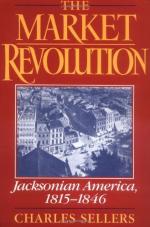
|
| Name: _________________________ | Period: ___________________ |
This test consists of 15 multiple choice questions and 5 short answer questions.
Multiple Choice Questions
1. What did Charles Finney try to do?
(a) Turn women into preachers.
(b) Turn capitalists into philanthropists.
(c) Turn slaveholders into preachers.
(d) Turn sinners into businessmen.
2. Where does Sellers situate Jonathan Edwards and Samuel Hopkins?
(a) On the more radical side of the antinomians.
(b) Between antinomians and Unitarians.
(c) Closer to Baptists than Unitarians.
(d) On the more conservative side of the Unitarians.
3. What did the antinomians believe in?
(a) Suppressing enthusiastic displays.
(b) Received Christianity.
(c) Radical conversion experiences.
(d) Strict religious practice.
4. What balance did the U.S. strike with the formation of a two-party system?
(a) Between capitalism and democracy.
(b) Between pro-slavery and abolition.
(c) Between hard currency and paper money.
(d) Between modern campaigning and grass-roots politicking.
5. What was Jackson's belief about markets?
(a) They needed heavy regulation by the government.
(b) They would regulate themselves.
(c) They tended to increase class inequality.
(d) They needed a strong central bank.
6. What was Horace Mann's relationship with the public school system?
(a) He resisted it.
(b) He designed it.
(c) He expanded it.
(d) He argued for regulating it.
7. What did the Moderate Light churches begin to focus on, according to Sellers?
(a) Race issues.
(b) Economic issues.
(c) Political issues.
(d) Social issues.
8. What did the Supreme Court say with regard to Jackson's policy about the Indians in Georgia?
(a) They gave Georgia freedom to deal with the Indians.
(b) They said the Indians had to be removed.
(c) They said the Indians were U.S. citizens.
(d) They said federal law prevailed.
9. What happened to John Calhoun's political power when Andrew Jackson was elected?
(a) It was exposed.
(b) It increased.
(c) It went behind the scenes.
(d) It waned.
10. When did zeal for reform reach the lower classes, in Sellers's account?
(a) Early 1820s.
(b) Mid 1820s.
(c) 1830s.
(d) Late 1820s.
11. What does Sellers say is the appropriate outlet for the sexual forces liberated in masturbation?
(a) Productivity.
(b) Education.
(c) Politics.
(d) The market.
12. What was NOT a contributing factor to the expansion of literacy in the U.S. in the 1830s?
(a) Industrial jobs required reading and writing.
(b) Media becomes even cheaper to produce.
(c) Immigration increased.
(d) Novels and newspapers were widely distributed.
13. What does capitalism result in, according to Sellers?
(a) The sterilization of sex.
(b) The celebration of sex.
(c) Repression of sex.
(d) The mechanicalization of sex.
14. On what grounds were people opposed to public schools?
(a) Anti-democratic.
(b) Discrimination against females.
(c) Racist discrimination.
(d) Exclusivity.
15. What was the result of the railroad system, in Sellers's account?
(a) Economic equality grew to historic disproportions.
(b) The U.S. saw poverty skyrocket.
(c) Wealth was concentrated in fewer and fewer hands.
(d) The U.S. became an industrial powerhouse.
Short Answer Questions
1. How did the desire of Northern manufacturers to restrict imports affect Southern planters?
2. What does Sellers say happened when northern manufacturers wanted to restrict imports with tariffs?
3. What was making the problem of male sexual liberation more difficult, in Sellers's account?
4. What did Biddle do in response to democratic pressure?
5. What is the only way to cope the with economic stress of the market, according to Sellers?
|
This section contains 569 words (approx. 2 pages at 300 words per page) |

|




